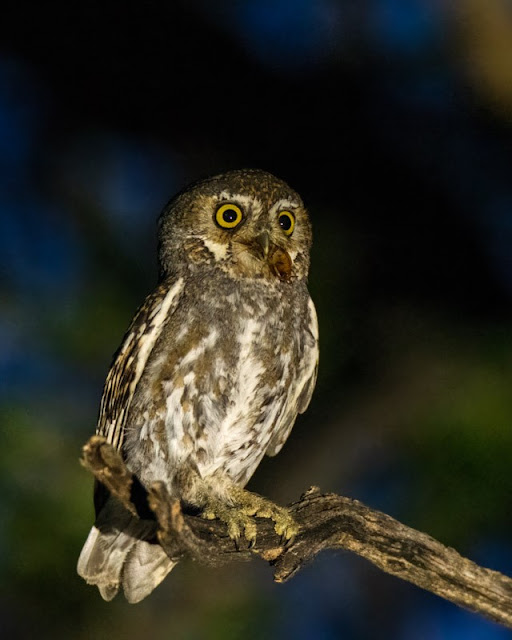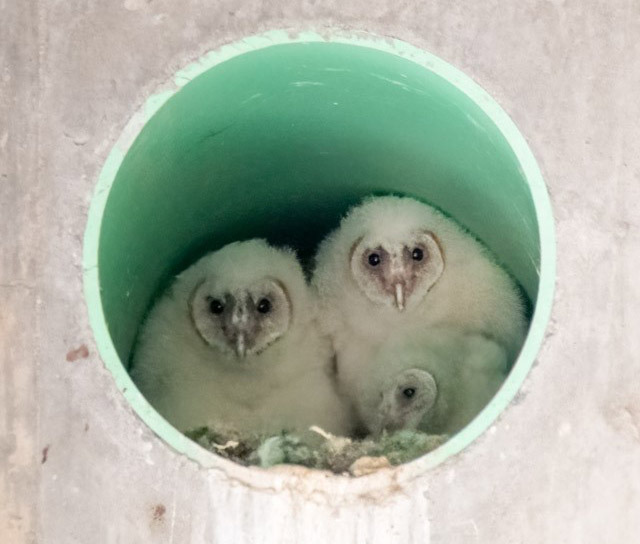Interesting Southeast Arizona Owls
By Dan Weisz
 |
| Elf Owl, all images by Dan Weisz |
May in Southeast Arizona is a great time to find owls! They are very vocal and you can usually hear at least one species calling in the dark night depending on what habitat you are in. Most people are familiar with the Great Horned Owl, the most common owl in the US and the largest in Arizona. You might also be aware of the Western Screech-Owl that we have in the desert areas around the city. Here is an introduction to three other owl species that we share the desert with.
The Elf Owl below was roosting in a cavity created by woodpeckers in a telephone pole. The only lighting available for this photo was a flashlight, and not a camera flash.
Photos of these Elf Owls were taken early in June. Elf Owls are not only the smallest owls in the world but the smallest raptors. Adults are about 5” tall--think of an index card or a juice box. Here is the male Elf Owl ready to deliver an insect to the female and owlets in the nest.
Elf Owls are only present in southern Arizona and the United States during the summer breeding season. The range map below indicates their entire range in our country. Although difficult to find, you may be able to hear Elf Owls in Tucson on a summer night in areas that are thick with saguaros and the saguaro cavities they nest in! After a very short while, we left the owls to their own for the evening.
This male Elf Owl was a very capable hunter and provided
well for his family. As short as he is, he looks robust with his
feathers, but an adult Elf Owl may weigh only an ounce and a half. That
is the weight of 1 or 2 pencils.
Barn Owls are found throughout the United States and throughout the world and on six continents. They are not found in Antarctica--not many rodents to feed on there! Barn Owls are cavity nesters and the photos below are of one nest “cavity" they used in southern Arizona this spring.
This pipe, imbedded in concrete, served this owl family well. There were three owlets in the nest.
To get a sense of what Barn Owl chicks sound like when they beg for food, listen to this Birdnote piece. When you hear the adult scream, you are hearing a sound that has been used by special effects teams in various monster movies over the years. That sound along with the look of an adult Barn Owl (all white with dark eyes, flying silently) is what gave rise to our current image of what a “ghost” looks and sounds like.
This owlet was the runt of the litter. Look at how undeveloped its face is. Its wings are cute but are of little help at this stage. The bird still has not developed the feathers that it will need to fledge.
The next photo was taken two weeks after the first image of the owls. You can see how much more their facial feathers have developed during that time. Even the little one has grown. The photo above of it with its silly looking wings was taken one week prior to the photo below. The runt is in the middle and his face has developed during this one week.
You can
listen to another Birdnote piece on how adult Barn Owls hunt.
One month later, Mom is still guarding the nest during the day, but the young are almost ready to leave the nest. This photo was taken two months after the first picture in this series. This video on how silently Barn Owls fly is one of my all-time favorite videos. It shows researchers in Britain studying the flight sounds and patterns of birds.
The third owl featured is a type of Ferruginous Pygmy Owl. There are 13 subspecies of Ferruginous Pygmy Owls in the Western Hemisphere. This is the Cactus Ferruginous Pygmy Owl and it nests in saguaro cavities in Southern Arizona. The Department of the Interior currently lists this subspecies as "Threatened."
I spent one morning in May, beginning at dawn, observing this bird family. Cactus Ferruginous Pygmy Owls are considered crepuscular, meaning they actively hunt at dawn and dusk. They are secretive and very fast. Here, a female is returning to the nest after the male had delivered this lizard to her. We know this is the female because of the wear on her tail feathers. Living in this closed nest cavity with rough edges has tattered her tail feathers. The male’s tail feathers remain relatively unworn.
Sometimes the males delivered food to the nest, but not always. That morning, after finding prey, he would perch somewhat close to the nest where the female would meet him to take the food. After a food delivery, the adult owl often left the nest again. The male would resume hunting and the female would await his food delivery nearby.
I think this was the male delivering another lizard to the nest. He paused at the entrance for a few seconds before dropping into the nest to pass the lizard on to the awaiting owlets.
It's a real treat to see these different owls in Southeast Arizona.
Dan Weisz is a native Tucsonan and retired educator who enjoys birding, being in nature, and taking photographs.












Comments
Post a Comment
Thanks, we value your opinions! Your comment will be reviewed before being published.